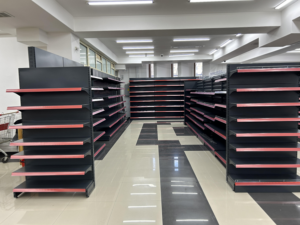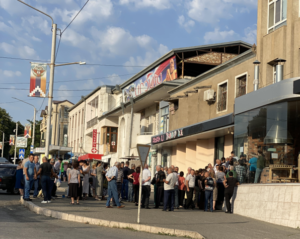
Picture of Mary Asatryan
By Aela Niget-Powers, Student at ESSEC Business School
In the midst of the South Caucasus lies the Republic of Artsakh or the Nagorno-Karabakh Republic, a mountainous and forested region inhabited for millennia by an ethnic majority fighting to preserve their Armenian heritage and culture. I spoke with Mary Asatryan, who is currently navigating life under blockade in Artsakh. Amidst sporadic electricity availability, she managed to share her experiences with me.
Context of the political situation in Nagorno-Karabakh
The blockade lies on the Latchine corridor for over nine months, the singular terrestrial link bridging Armenia and Nagorno-Karabakh. Azerbaijan chose this particular site to barricade for its obvious strategic advantages. From a geopolitical perspective, Azerbaijan asserts its sovereignty claim over Nagorno-Karabakh, while Armenia lends support to the ethnic Armenian populace of the region. Mary begins the interview by stating that Azerbaijan’s corridor closure has shadowed the flow of life. Nagorno-Karabakh’s dependency on this route for vital imports has resulted in a situation where necessities such as food, medicine, energy, and bare essentials are in short supply due to the blockade. Once fully stocked, store shelves now stand empty in silent testimony to the blockade’s impact.

Photo taken by Mary Asatryan of empty shelves in a local grocery store
“There is a complex narrative embedded in Nagorno-Karabakh’s history. Although of serious consequence, the current blockade represents the tip of a titanic iceberg, ” Mary aptly noted.
In the intricate fabric of Nagorno-Karabakh’s past, we encounter a mosaic of diverse cultures tightly knit to the region’s predominantly Armenian population. The origins of the ongoing conflict can be traced back to the early 20th century, when the area became entangled in the folds of the Russian Empire, igniting sparks of nascent nationalism.
The Soviet era added caustic layers of control, steering Nagorno-Karabakh under the governance of the Azerbaijan Soviet Socialist Republic despite its prevailing Armenian majority. A crucial juncture emerged in 1923 when Joseph Stalin granted autonomous status to the region under Azerbaijan’s continued supervision, a decision that would resonate with geopolitical implications.
The region experienced a rush of renewed nationalism and reignited identity, especially as the Soviet Union’s authority declined in the late 1980s. This resurgence unleashed a deeply entrenched conflict concerning the sovereign status of Nagorno-Karabakh. Dormant tensions flared into open hostilities, with Armenia and Azerbaijan clashing vehemently over contested territories. The ethnic Armenian population of Nagorno-Karabakh sought to reclaim their historical homeland, countering Azerbaijan’s claim to sovereignty over the region.
A full-scale war erupted in the late 1980s and early 1990s, characterized by a distressing blend of suffering and violence on both sides. A ceasefire arrangement brokered in 1994 temporarily curtailed direct combat, yet it left Nagorno-Karabakh and its adjacent areas under Armenian control, with the question of its political status unresolved. Despite intermittent flare-ups, attempts toward overall resolution remained largely stagnant, with international mediation efforts persisting through the OSCE Minsk Group.
In the year 2020, heightened tensions yielded another dramatic resurgence of violence. Azerbaijan launched a significant military campaign to reclaim what it perceived as its sovereign territory, receiving support from Turkey. This conflict brought about substantial shifts in territorial control as Azerbaijani forces advanced into Nagorno-Karabakh and surrounding regions. The ensuing ceasefire agreement, brokered by Russia in November 2020, marked a critical moment of de-escalation. This agreement effectively halted active hostilities, establishing a new framework in which Armenia ceded certain districts surrounding Nagorno-Karabakh. Russian peacekeepers assumed responsibility for maintaining the ceasefire and ensuring stability.
Life behind the blockade
Caught in the constricting embrace of the blockade, Mary paints a vivid picture of life where the search for the most basic essentials has become a daily battle. In a world punctuated by the absence of water, sustenance, fuel, and electricity, she narrates a harrowing story of survival, where even the simplest act of procuring bread is a strategic maneuver.
“It’s all about survival,” Mary declares, “A sentiment etched in the hearts of all those living through the ordeal. The pursuit of each day revolves around strategizing how to navigate through a landscape of deprivation.”
The people wake up early to travel to the nearest bakery and then queue in line for the rest of the day and into the night, driven by the faint hope of securing enough sustenance for the family’s one meal the next day. They wait one after another with kin and neighbors, conversing patiently and respectfully with other community members for the sake of their infants and elders who cannot fend for themselves.

Photo by Mary Asatryan of the daily queue for bread
“Why must securing our fundamental rights be such an uphill battle?”
Mary voices the collective frustration that echoes across their isolated enclave. The aspiration to live freely, unburdened by the shackles of scarcity, is a sentiment that reverberates profoundly. Mary’s recollections carried her back to the month in December when the curtain of isolation descended—a period riddled with the hope that diplomacy and the intervention of Russia might convince Azerbaijan to withdraw their troops. But as tents went up and days turned into nights, they painfully came to the realization that Azerbaijan had planned the occupation to force their own terms of final resolution. Anxiety simmered beneath the surface, with the stark understanding that this journey would stretch far beyond a handful of days.
Mary, however, paints a portrait of resilience buoyed by community bonds. When the dust settled on the empty shelves, people rallied through the power of digital connections. Social media transformed into a lifeline, where assistance flowed freely with medicine, sustenance, or clothing offers.
Mary recounts the epitomal experience that encapsulates the spirit of shared humanity. Waking up one morning feeling completely drained, Mary turned to social media when the prospect of standing another day in line for bread felt insurmountable. The number of supportive responses was astonishing. However, the action of one 15-year-old boy, an acquaintance who lived behind the blockade, was overwhelming. The following day, he arrived with a loaf of bread after spending the night waiting in line. Mary’s voice softens with emotion in recounting this story, revealing how this small act of kindness etched a profound mark. The young boy’s determination to share with another prisoner beyond his own circle of family and friends reveals the core value and strength of community spirit that exists among the people of Nagorno-Karabakh. In the midst of terrifying adversity, these experiences of solidarity become precious stories of hope, reminding Mary and all others behind the blockade that they are not alone but can endure if they unite.
“In the crucible of adversity, our community has become an unbreakable bond,” Mary’s voice resonates, highlighting the indomitable spirit that emerges when survival hinges on solidarity. “We’re each other’s lifelines. It’s a fact – we only have each other.”
Mary’s narrative expands to reveal further stories of resilience that have arisen through their collective experience, or as Mary described, “the small things that keep you going” in the midst of hardship. The anecdotes have become a source of fortitude, revealing the lengths to which the people of Nagorno-Karabakh will go to support one another in the face of overwhelming odds.
Mary’s aspirations rise beyond the horizon of their immediate struggle. Hope finds its voice in her words as she envisions a future where their rights find the respect they deserve, even amidst the disparate claims to sovereignty that have repeatedly concluded in war. In the face of blocked humanitarian aid, Mary turns her gaze towards international obligations. She seeks solace in the notion that sanctions might be wielded as a means to preserve the sanctity of their human rights and uphold the tenets of law and order.
“A crime unpunished is a crime repeated,” Mary states with conviction. “Accountability is a linchpin in the journey toward a just resolution.”
Looking beyond the present, Mary fervently hopes their situation won’t fade into the backdrop of normalization. Basic rights, she underscores, should be non-negotiable, fundamental pillars that sustain any society. Their ordeal, she fervently believes, should serve as a poignant lesson, a stark reminder that must not be allowed to be repeated in the annals of history. Mary’s aspiration transcends the confines of her own community, speaking to a greater narrative of the collective responsibility to prevent the recurrence of such injustices.

Aela Niget-Powers
Aela is a student at ESSEC Business School, holding dual French and American citizenship. Committed to her passion for the arts, she attends night classes at l'école du Louvre to further her knowledge and appreciation of artistic expression. Aela has explored diverse cultures worldwide, fostering a global perspective. Her editorial endeavors are driven by a desire to elevate conversations, infusing them with a nuanced exploration of the dynamic interplay between art and society.